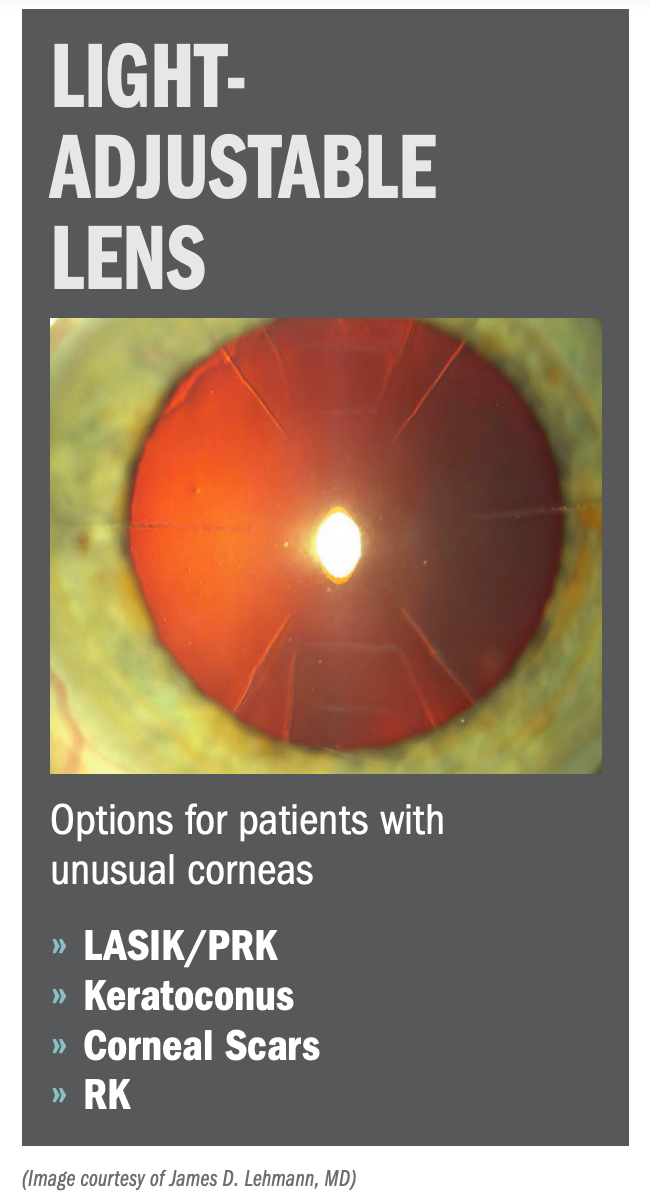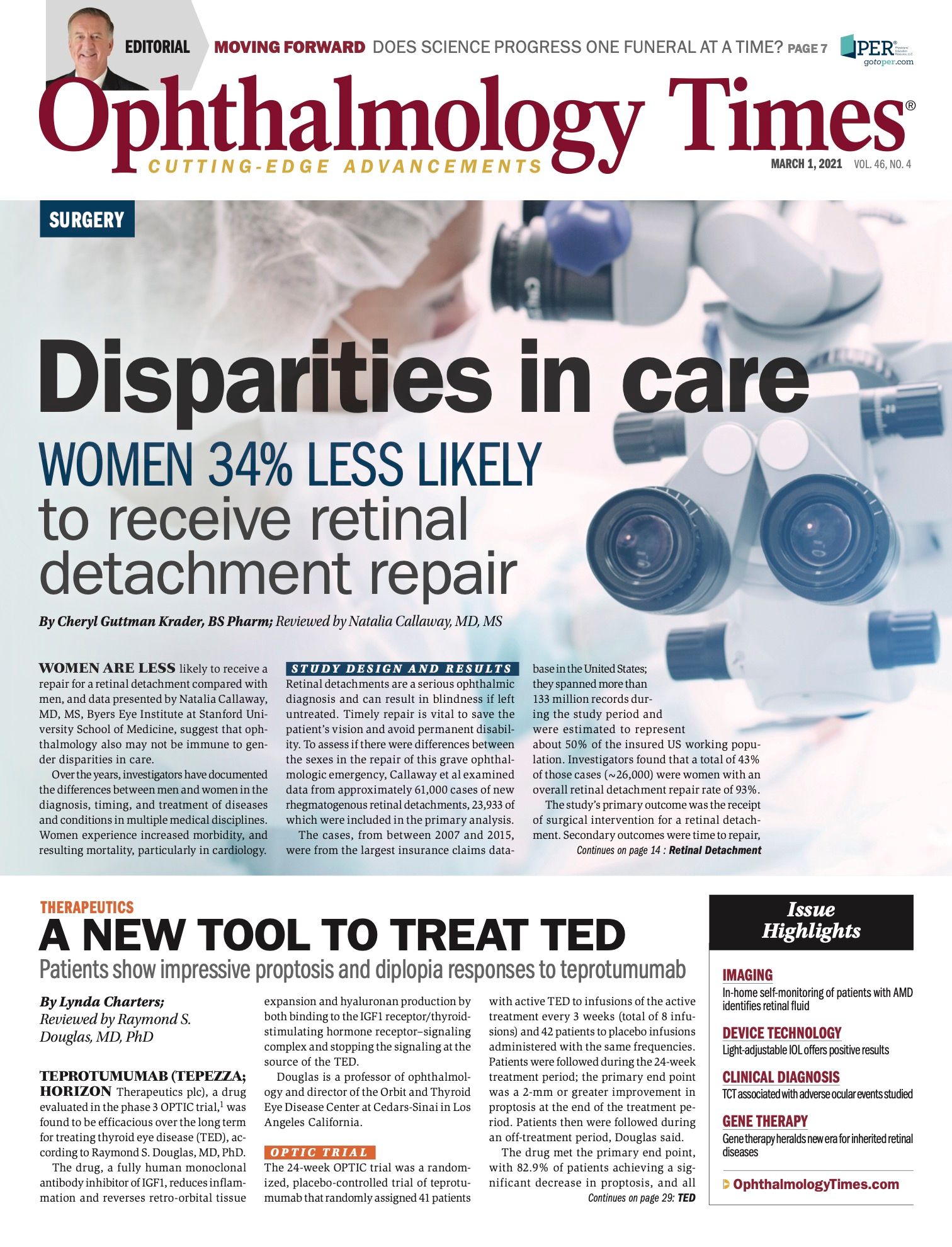Publication
Article
Digital Edition
Light-adjustable IOL offers positive refractive results in patients
Author(s):
New option may prove to be a solution for cataract cases with unusual corneas.

This article was reviewed by James D. Lehmann, MD
The light-adjustable lens (LAL; RxSight) may be a good solution for patients with cataracts who have unusual corneas, including patients with a history of radial keratotomy (RK).
According to James D. Lehmann, MD, these patients may otherwise have less-than-optimal postsurgical refractive outcomes compared with patients with normal corneas, of whom from 80% to 90% are expected to achieve results within 0.5 D of the target refractions following cataract surgery.
Related: Visual outcomes of small-aperture IOL implant in post-laser refractive eyes
“The refractive outcomes in patients who have undergone RK are even more difficult to predict than those treated with LASIK or PRK,” said Lehmann, who is in private practice at Focal Point Vision in San Antonio, Texas.
He recounted a recent study that found the best percentage within 0.50 D achieved in patients who had previously undergone RK was 69.2% in the short term.1
“The difficulty in predicting outcomes in post-RK cataract [cases] is a consequence of the small, irregular optical zone, irregular astigmatism, and an altered anterior/posterior ratio,” he said. “And [despite] useful tools [such as] intraoperative aberrometry, the ASCRS IOL calculator, and modern intraocular lens formulae, we still struggle to obtain consistent postoperative refractive results.”
Another study looked at the percentage within 0.5 D after RK 2 or 3 months following cataract surgery and found that results achieved with the various refractive formulae ranged from 50% to 63.5% in patients who were within 0.5 D of the desired refraction.2
Related: Dispelling myths about refractive lens exchange

The LAL solution
The LAL consists of a silicone optic with a special adjustable intraocular matrix supported by standard polymethyl methacrylate haptics.
“Following cataract surgery, a specific wavelength of light is shone on the optic to change its shape, thus changing its refractive power and helping to dial in the desired refraction,” Lehmann explained.
This FDA-approved technology has been shown to work well in normal corneas, with the vast majority of eyes in the phase 3 FDA trial (92%) achieving 20/25 and almost 92% achieving results within 0.5 D of the target manifest refraction spherical equivalent.3
Related: Early clinical experience with next-generation lens
Lehmann and colleagues wanted to examine how the LAL performed in post-RK corneas in both the short and long term. They performed a retrospective review of all patients (post RK) who received the LAL and identified 23 eyes in 14 patients.
The primary end points were the mean absolute error (MAE), the percentage of eyes within 0.5 D of target, and the mean refractive shift over time.
All patients underwent cataract surgery bilaterally 1 week apart and returned for a series of light adjustments beginning 2 weeks after the second surgery.
Regarding the short-term results, Lehmann reported that the postoperative MAE before adjustment was 0.94 D and the percentage of eyes within 0.5 D before adjustment was 48%.
This suggests that if the IOL were not adjustable, the results would be similar to the published data. However, after adjustment, 95.7% of eyes were within 0.5 D and the MAE was 0.27 D. Only 1 eye did not get within 0.5 D of target.
Related: Iris-fixated IOLs are a boon for treating high myopia
The long-term results obtained at an average follow-up of 40 weeks indicated that the MAE was 0.43 D and the percentage of eyes within 0.5 D was 78.26%.
These findings represented a decrease from the short-term results in both parameters, but the results were still good, Lehmann noted.
Additional analysis of the refractive shift in the long term showed an average shift in the spherical equivalent of –0.13 D and an absolute value shift in the spherical equivalent of 0.27 D. The average follow-up of 17 eyes was a mean of 50 weeks (range, 32-70).
Lehmann noted that this translated to a shift that was not great over the long term.
Related: Avoiding IOL refinements after presbyopia-correction surgery
“We concluded that the LAL worked well in patients who had undergone a previous RK,” he said. “The MAE and percent within 0.5 D were better than the published data, and the long-term data also were good, although not as impressive as the short-term data. We observed a minimal refractive shift at a mean of 1 year postoperatively.”
--
James D. Lehmann, MD
e:lehmann@focalpointvision.com
Lehmann reported that he is a consultant/adviser to and equity owner in RxSight.
--
References
1. Turnbull AM, Crawford GJ, Barrett GD. Methods for intraocular lens power calculation in cataract surgery after radial keratotomy. Ophthalmology. 2020;127(1):45-51. doi:10.1016/j.ophtha.2019.08.019
2. Curado SX, Hida WT, Vilar CMC, Ordones VL, Chaves MAP, Tzelikis PF. 3. Intraoperative aberrometry versus preoperative biometry for IOL power selection after radial keratotomy: a prospective study. J Refract Surg. 2019;35(10):656-661. doi:10.3928/1081597X-20190913-01
4. FDA. Summary of safety and effectiveness data. https://www.accessdata.fda.gov/cdrh_docs/pdf/P930014S015b.pdf

Newsletter
Don’t miss out—get Ophthalmology Times updates on the latest clinical advancements and expert interviews, straight to your inbox.




